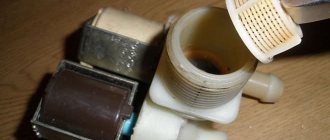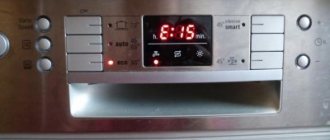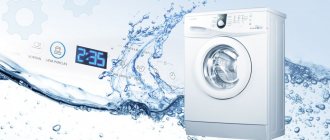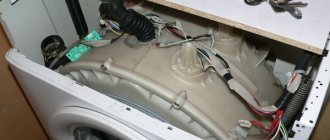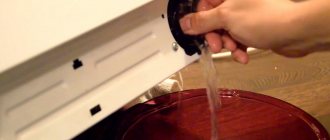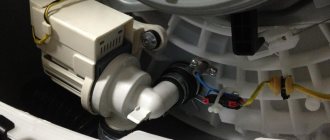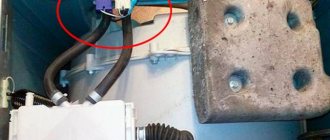The washing machine can continuously draw water both during washing and when turned off. This is a consequence of a malfunction that needs to be corrected. Let's look at the reasons for its occurrence, and what you can do yourself without involving a household appliance repairman.
- Causes of failure
- Incorrect sewer connection
- Water fill valves are faulty
- Breakdown of the pressure switch
- Control block
- Catalog of washing machines with reviews
Causes of failure
If water flows onto the floor, then the culprit is a leak. It occurs when elements of the machine are damaged, primarily:
- rubber pipes and hoses;
- hole in the cuff;
- crack in the tank.
This is an emergency situation in which the washing machine cannot be used. You need to remove the top and back covers and look for leaks using traces of water. After fixing it, the problem will go away.
In this case, water is poured continuously due to the fact that it must reach a certain level. And since it constantly flows out, the supply does not stop.
The washing machine overflows water
If there is no leakage, the source is the following:
- incorrect connection of the MCA;
- valves are faulty;
- breakdown of the pressure switch;
- problems in the control unit.
Let's look at everything in more detail.
Prevention measures
Simple recommendations from experts will help prevent unpleasant situations when using technology.
Rules to follow:
- The device must be cleaned periodically. For this purpose special means are used. Simple citric acid will gently clean your equipment.
- Foreign parts, which are often forgotten to be removed from pockets before washing, get stuck in the machine and cause breakdowns. Therefore, before washing, all clothes are checked and sorted. Items with sequins or rhinestones should be turned inside out.
- Failures and malfunctions in equipment can be seen in advance if you do regular inspections.
- Each item has a label that includes washing instructions. All items are washed according to the recommendations.
- After finishing washing, it is necessary to close the shut-off valve. When the tap is open, the outlet valve membrane is constantly under high pressure, which causes it to wear out quickly.
- To prevent waste from the sewer from returning to the drum, it is necessary to install a check valve.
Online diagnostics of a washing machine
If your machine stops washing or rinsing clothes normally, then some kind of malfunction or breakdown has occurred.
You can try to find the problem yourself. Run diagnostics
Select which operation your washing machine does not perform:
1. Doesn’t drain 2. Doesn’t rotate the drum 3. Doesn’t spin clothes 4. Noises, knocks, buzzes when spinning 5. Doesn’t turn on
Checking the operation of the drain pump Is the drain pump of the washing machine working? Yes No I don’t know << Back
Clogged hoses in the washing machine If the sound corresponds to the normal sound that has always been observed when the device is working, the cause is probably a clog.
Was there a blockage in the drain hose? Yes
<< Back
The drain pump does not work! If the sound matches the normal sound of the drain pump, it is recommended that you check the drain filter first.
After cleaning, does the drain pump work and does the washing machine drain water? Not really
<< Back
Operation of the drain pump The sound of the pump is usually immediately audible and noticeable. If there is no sound, the pump is not working. We are looking for how to separately enable the water drainage program. As a rule, this is a separate option. After the program has been turned on, the pump should start working in 1-3 seconds. If everything is done correctly and the pump is operational, a buzzing sound will appear. If you hear no buzzing or other sounds when you turn on the program, the pump is probably faulty.
Is the washing machine drain pump working? Not really
<< Back
Clogged car hoses If you have identified a clog in the hoses, you need to disassemble them, clean them, and then reassemble everything.
Does the washing machine drain well? Not really
<< Back
Hurray, you did a great job, you fixed it.
<< Return to the beginning of diagnostics
The drain pump is faulty, call a professional.
<< Return to the beginning of the diagnosis.
The washing machine does not rotate the drum. During the operation of the washing machine, such a problem may occur. Each model has a different drum operation. It rotates according to a given algorithm, which is set by the program. This principle applies to spinning and washing. If you are not sure whether the drum is not spinning or whether it is working, put the laundry in the washing machine. Start the spin program. If the machine is running, it will first drain the water and then start spinning. In this case, a rotational process will be observed. If rotation is not visible, then check the belt. First, turn off the program, then unplug the wire from the outlet so that power does not flow into the device. Now you need to remove the back cover. You will need to carefully inspect the drum belt. It is quite easy to determine whether it is in the wrong position or damaged.
Is the washing machine belt torn or stretched? Not really
<< Back
Broken drum drive belt If the belt breaks, it will be immediately visible. There are also often cases when the belt simply stretches, which is why the drum, accordingly, does not rotate. Do not allow the machine to operate if the belt breaks. It is important to check whether it has wound around the engine pulley or broken the wiring to the engine. The heating element and temperature sensor may also be damaged if the belt does catch the wires. It is imperative to ensure that the belt model is original. If you choose an unsuitable or low-quality product, this will affect the performance of other devices. How do you know what kind of belt you have? There will be a marking written on the old one, compare it with the one indicated on the belt offered to you. You can also find out belt information by car model.
<< Return to the beginning of the diagnosis.
Washing machine motor malfunction If a malfunction is not found, the block with wires must be disconnected from the electric motor. Carefully remove it. We visually evaluate the engine. It may have melting, cracks, or other effects that clearly indicate damage. We call the windings of the tachogenerator and the engine. It is important to understand that you can fully study how correctly the engine operates and whether there is a malfunction only at the stand. If rotation does not occur, there may be a problem with more than just the motor. Sometimes the cause is a malfunctioning electronic module. If a short circuit occurs in the engine, the module could be damaged, while the engine remains operational. Also, the wires could be damaged.
<< Return to the beginning of the diagnosis.
Repairing a washing machine that does not spin clothes After completing the washing process, the washing machine may not spin properly or may not start spinning. Firstly, look, perhaps another mode is set, which does not involve turning on the spin cycle at all. This happens, for example, with programs related to washing woolen items and delicate fabrics. To check, run the spin cycle separately. If the washing machine does not drain water, we proceed to check the pump.
Does the washing machine now spin clothes? Not really
<< Back
Congratulations, you have solved your problem!
<< Return to the beginning of the diagnosis.
Repair of washing machines, imbalance Modern washing machines place the laundry on the drum before spinning. This is necessary for quality work. Check if this feature works. Sometimes a situation occurs when things get wrapped up in a ball that cannot be unwound automatically within a certain time. At this point the work stops. You need to unwind this laundry yourself, lay it out and continue operating the washing machine. In this case, it is important to turn off the machine, and then, when the laundry is laid out, turn on a separate spin program.
Does the washing machine now spin clothes? Not really
<< Back
Washing machine repair, drum drive repair Now you need to check the drum drive belt. We remove the cover and visually assess the condition of the belt. There should be no damage. If the tension is weak, the spin may not turn on. If you need to replace the belt, you should only replace it with the original one. After replacing, we try the program again.
Fault found, does the washing machine spin? Not really
<< Back
The engine or electronic module is faulty, call a repairman to your home.
<< Return to the beginning of the diagnosis.
The washing machine hums, makes noise during the spin cycle, rumbles, and makes a jet plane noise. If the washing machine makes noise during operation, making unusual sounds, it’s time to pay special attention to it. In this case, a visible breakdown or lack of functionality may not be observed, but the appearance of strange sounds indicates that it is time to look for a malfunction. It is important to understand that a new car that has just been delivered should be inspected for shipping bolts. If you forget to remove them, noise and vibration are inevitable. So, let's begin! We turn the washing machine drum and listen to extraneous sounds.
When rotating, do you hear extraneous noise, hum, balls rolling, does the drum move unevenly with slight jamming? Not really
<< Back
If the drum rotates and uncharacteristic sounds appear, including vibration, it’s time to check the bearings. If they malfunction, they will have to be replaced.
<< Return to the beginning of the diagnosis.
The counterweight of the washing machine has come loose. The fastening of the counterweights must also be of high quality. If they are “loose”, it’s time to eliminate this defect. In some cases, you can notice that the bolts that secure the stones are completely missing. In this case, the connectors for mounting will be visible. The bolts need to be found and put in place - they probably simply came loose. A rumble heard while the washing machine is operating may indicate that the bolts have partially loosened. To check the bolts, you can simply push the drum. If it is secure, the bolts are fine. If it moves, there is a defect.
Do you hear any noise, clanging or rattling noises when moving the washing machine tub? Not really
<< Back
The counterweight has come off
<< Return to the beginning of diagnostics
Checking the shock absorbers of the washing machine Checking the shock absorbers. If you hear vibration or excessive noise during the spin cycle, there may be a problem with the shock absorbers. Sometimes the washer moves. Now let's check the functionality. Remove the top cover. Click on the tank, move it five to seven centimeters down. A normal reaction will be observed if the tank rises sharply, jumping a little and stopping in its normal place. If this does not happen, the shock absorbers need to be replaced.
Are the shock absorbers of the washing machine working? Not really
<< Back
If a visible defect has not been identified, check whether a foreign object may have entered the machine. Replacing shock absorbers. The problem with shock absorbers wearing out occurs quite often over time.
<< Return to the beginning of the diagnosis.
Replacing washing machine shock absorbers. Malfunction and wear of shock absorbers is a fairly common phenomenon.
<< Return to the beginning of the diagnosis.
The washing machine does not turn on. It is worth trying to find the cause of the problem yourself and fix it. We start by connecting the device to the network. Next, click on the “network” button. In different car models, different indications are triggered: here either the display will start working, or, on the contrary, some other button.
Does the washing machine have an indicator? Not really
<< Back
Hatch lock lock (UBL) You can check it by turning on any of the programs. We choose what we will use. Click on the corresponding button. Don't forget to pay attention to the inclusion. As a rule, the process of activating a function is characterized by the presence of a certain sound, for example a click, with which the device makes it clear that pressing again is not necessary and the machine is already working. If there is no sound, the button may be broken. In this case, the main thing that must be done is to block the hatch and start working. If this happens, everything is fine.
The washing machine is blocking the hatch and the UBL is triggered? Not really
<< Back
Water fill valve malfunction
<< Return to the beginning of the diagnosis.
The washing machine hatch does not lock
<< Return to the beginning of the diagnosis.
No indication Checking the electrical circuit. If you notice that the washing machine does not respond to being turned on, it is first recommended to check the power supply. The outlet may be faulty. Try connecting another device. If the outlet works, you need to check whether the circuit that conducts energy through the washing machine from one element to another is intact. To do this, you will need a multimeter, which will help you fully analyze the ability to respond to an electrical signal at several stages of operation. If there is no network connection anywhere, this is probably the problem. We carry out this manipulation until we reach the electronic module. If we are talking about an old washing machine, here it will look like the device’s program. When you turn on the button, there should be no breaks in the circuit. If the circuit works, everything is fine electrically.
Is the washing machine's power supply OK? Not really
<< Back
Repair of electronic module (unit)
<< Return to the beginning of diagnostics
Contact circuit fault
<< Return to the beginning of diagnostics
What needs to be done in such cases
If there is water left in the detergent and rinse aid tray in the washing machine.
If you notice small amounts of water remaining in the dispenser compartment intended for the air conditioner, then there is no need to raise the alarm, this is acceptable. But if significant amounts of water remain in the powder or rinse aid compartments, then the necessary measures will have to be taken.
To do this, let’s find out the reasons why water remains in the washing machine:
- The detergent dispenser was not properly maintained. We can conclude that in this case it is necessary to service the tray somewhat more often. You should take it out and rinse thoroughly.
- Incorrect installation of the washing machine. Your washing machine is probably not level relative to the horizontal plane. The installation must be carried out correctly.
- Are you confident in the quality of the detergents you use? Perhaps water remains in the washing machine after washing due to poor quality powder or conditioner? Try replacing these products.
- Have you gone too far with the proportions? It may turn out that you added more powder than you should. It could clog the drains. We recommend using measuring cups.
- The water pressure may be insufficient. Check that you have fully opened the water intake valve. If yes, then most likely the problem is in the general water supply, contact the management company.
| If there is water in the washing machine door seal | No need to worry, this is normal. All you need to do is wipe the cuff with a dry cloth after each wash. |
| If water remains in the drain filter. | This situation also cannot be called a malfunction. If your machine is installed correctly, then the hose in the drain system is installed in the form of a loop. After washing, water remains in this loop, which ends up in the drain filter. No worries. |
| If your washing machine still has water in the drum, the wash appears to be completed, but the door is locked. | Check if it is possible that you have selected a washing program designed for delicate fabrics? This program includes a water stop. If so, simply activate drain mode. If the problem is not in the program, then most likely the problem is damage to the pump. Here you will have to turn to specialists. |
| If water gets into the washing machine when it is turned off. | First of all, you need to conclude what type of water unexpectedly ended up in your machine. If the water has an unpleasant odor and a cloudy appearance, it means that it came from the sewer and the drainage system should be checked. If the water is clearly clear, then it came from the water supply and the problem is in the inlet valve. |
Incorrect sewer connection
If the automatic washing machine is incorrectly connected to the sewerage system, then a “siphon effect” or, in other words, “self-draining” occurs. That is, water flows out of the washing machine itself, without the help of a drain pump. Many people don't even understand this.
Some SMAs stop and display an error code, which means there is not enough water in the tank. Others are constantly adding it. In principle, if an error does not occur, then you can operate the machine this way. But this leads to significant waste of water and electricity.
Expert opinion
I work in the household appliance repair industry. Extensive experience in restoring washing machines and dishwashers.
Ask a Question
Simple rule! The end of the drain hose should be higher than the water level in the tank, and not fit tightly into the sewer pipe. An air gap is needed.
Based on this, it seems optimal to connect to a special outlet above the sink siphon, or attach it to the edge of the bathroom using a bend. But this option, for aesthetic reasons, not everyone likes.
By changing the drain hose connection, the problem will go away.
Programmer malfunction
The causes of malfunctions of washing machines are varied, but the most common ones also include defects in the “brain” software. The programmer in SMA is designed according to the electromechanical type, often combined with a special microcontroller. Delivery of a new programmer from the manufacturer usually takes a very long time, so it will be easier to contact a specialist who will always have a set of vital parts for the SMA. A specialist will always figure out why water is not flowing. Moreover, in most cases there is no need to replace the entire unit and it only concerns a couple of burnt contacts that are damaged by the ingress of water or cleaning solution. As a result, a short circuit occurs.
Contacts are cleaned using a special liquid. You can use a syringe to apply it. In most cases, the deposit is not too significant, so the method can work the first time. If the problem is not in the contacts, but in the microcontroller, then you can’t do without special knowledge, even if a citizen decides to deal with the programmer himself. Therefore, if cleaning the contacts yourself does not help, in any case it is advisable to call a specialist so as not to make repairing the machine even more expensive. The master is able to disassemble and reassemble a unit that is considered unassembled by the average person.
There are a number of reasons why the washing machine does not fill with water. However, some of them can be solved even without financial costs, independently, with minimal technical knowledge. In other cases, when the factors are not justified by malfunctions in the operation of the filter, tap or water supply pipe, a qualified specialist is highly desirable.
Be attentive to your household appliances and promptly seek help from specialists!
Household appliances are a modern assistant for housewives. We are all so accustomed to using various devices every day that any incorrect operation of them causes genuine horror. For example, you started washing, put things in the washing machine, added powder, selected a program and... Nothing happens, the washing machine does not fill with water. It seems like the situation is complicated, because without water “there’s no way to go here or there.” But do not aggravate the situation, since the reasons that the machine does not take in water can be quite commonplace. Let's figure it out and consider what simple or complex reasons led to the cancellation of the washing process.
Water fill valves are faulty
The operating principle of this device is as follows:
- they are constantly closed all the time;
- when voltage is applied, they open, and water, under the existing pressure in the pipe, enters the tank.
There is an electromagnetic coil inside the valve, which can burn out over time. The locking mechanism may also become damaged or jammed. As a result, water continuously flows into the machine.
Filling valves. There are also triple and single ones.
It is not advisable to repair the valves, but you need to buy and install new ones. The design and principle of operation itself provides for wear and tear of this device. An attempt at restoration will give a temporary effect, and may ultimately lead to flooding of your and your neighbor’s apartment.
Expert opinion
I work in the household appliance repair industry. Extensive experience in restoring washing machines and dishwashers.
Ask a Question
The fact is that a faulty valve can let water through, even if the washing machine is turned off and disconnected from the power supply.
To protect yourself from flooding, you need to purchase an SMA with the full AquaStop system. This is protection against leaks.
Are you unplugging your washing machine?
Oh yes! No
Breakdown of the pressure switch
This device detects the water level, and when it reaches the value corresponding to the washing cycle, a signal is sent to the control module. Which, in turn, turns off the valves and water stops flowing into the machine.
A faulty sensor does not determine how full the tank is. As a result, water flows continuously. The pressure switch rarely breaks!
Breakdown may occur over time. The inner membrane has hardened and lost its ability to bend. In this case, replacement with a working one is necessary.
Expert opinion
Sometimes the contacts oxidize and the signal does not pass through. After cleaning, you need to check the functionality.
The rubber tube may also become clogged or cracked. After replacing or cleaning, the problem will disappear.
One option is an electronic pressure switch
The drum is leaky
It is not difficult to notice damage to the washing machine tank: if you see a puddle under the device after a wash cycle, it means there is a leak inside and the machine must constantly replenish it. In many cases, when the device is located in the corner of the room or is crowded with furniture, the leak may not be noticed, so we recommend that you feel the drum with your hands several times a month for holes. Sometimes a specialist will patch the leak, but more often the entire part will have to be replaced. The easiest way to do this is with LG devices.
Control block
In a modern automatic washing machine, all components are controlled by an electronic module, which is essentially a computer with software. If the valve circuit is damaged, the controller does not turn them off and water is constantly drawn in.
In this case, two options are possible:
- buying a new one;
- repair.
It is not always possible to find a new module that matches the SMA model. Sometimes you need to wait 2-3 months. In addition, it needs to be flashed with a program. He won't work without it. It's like a computer without Windows.
For restoration, it is best to contact a specialized washing machine repair service.
SMA control module
Let us note right away that this breakdown is not typical for any particular brand, but is inherent in all SMAs: Samsung, LG, Bosch, Electrolux, Zanussi, Ariston, Indesit, Virpull. , "Kandy", "Hansa", Gorenje, "Ardo", "Beko", "AEG", "Miele", "Siemens", "Kaiser" and "Atlant".
